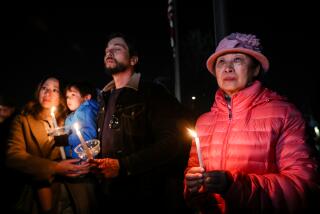Judge Rejects Claim That Juries Bar Asians : Courts: He says motion by defense attorneys in the Stuart Tay murder trial and other high-profile cases ‘borders on being frivolous.’
- Share via
SANTA ANA — A judge on Wednesday rejected claims that Asians are systematically excluded from the Orange County Grand Jury and ruled that there is no legal requirement for “quotas” to ensure racial diversity on the volunteer panel.
Defense attorneys in the Stuart A. Tay murder trial and other high-profile criminal cases contend that the lack of Asians on the 1992-93 grand jury stripped their clients of a constitutional right to have an ethnically mixed jury decide their fate.
But in a 17-page ruling released Wednesday afternoon, Judge Theodore E. Millard said the attorneys’ motion “borders on being frivolous” and found there was insufficient evidence to support defense requests to dismiss indictments.
Millard’s ruling also noted that there is no case law requiring jury “quotas.”
“The process utilized by the court to empanel the grand jury is one of inclusion, not exclusion,” Millard wrote. “Much time and effort is made to solicit applications from qualified minority, racial and ethnic individuals here in Orange County.”
Prosecutors and attorneys for the county praised the ruling. Defense attorneys said the decision made Asians “invisible” in Orange County.
“Obviously, I’m disappointed,” said defense attorney Marshall M. Schulman, who represents one of three Asian defendants accused in the Tay slaying. “According to this, Asians have become invisible.”
One of the more unusual aspects of the case involved deciding whether Asians represented a “cognizable” group, given the dozens of nationalities and cultures that are generally included in that category.
Millard ruled that Asian residents cannot be grouped together, especially since they do not all speak the same language.
During a recent hearing on the motion, a defense expert testified that in 1992, Asians made up 11.7% of Orange County’s population. But only two Asians applied to the grand jury, and later they withdrew their applications from consideration for the panel that handed down the indictments at the center of the defense motion.
Prosecutors and county attorneys denied that there is any systematic exclusion of minorities and also contended that they were being taken to task for the public’s lack of interest in what many agree is a thankless job.
Grand jurors serve for a full year for a maximum of $100 a week.
“We’re very pleased, this is what we have been saying all along,” said Deputy County Counsel Edward N. Duran.
Millard said defense evidence documenting the lack of racial minorities is not evidence of a “constitutional defect” in the selection process.
“The Constitution does not yet require quotas or proportional representation of races, nationalities or any other identifiable segments on a jury,” he said.
The defendants who mounted the challenge include four teen-agers accused of killing Foothill High School honor student Stuart A. Tay on New Year’s Eve, 1992; Alicia Hanna, a Santa Ana clinic owner accused of murdering a woman during a botched, illegal abortion in January, 1993; and several defendants charged in a massive auto insurance scheme.
While the court’s decision paves the way for the defendants to proceed to trial, some defense attorneys may consider asking an appellate court to review the ruling, Schulman said.
The Orange County Grand Jury has come under increasing attack in the last year. Many in the minority community have complained about the panel’s lack of minority representation in the wake of a grand jury report that linked illegal immigration to a wide array of society’s ills.
The report prompted outrage and helped trigger an upcoming fact-finding hearing by a panel of the U.S. Commission on Civil Rights.
The grand jury recently answered criticism that it is out of touch with the county’s ethnic minority population by suggesting ways to improve its diversity. Schulman pointed to the report Wednesday as evidence that his motion was not frivolous.
“Why would (the grand jury) say that if it wasn’t significant?” Schulman said.
More to Read
Sign up for Essential California
The most important California stories and recommendations in your inbox every morning.
You may occasionally receive promotional content from the Los Angeles Times.











